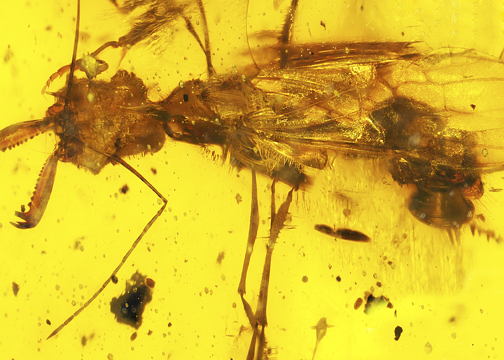Abstract
Odontomachus is a remarkable ant genus due to the fast mandibles with kinetic action, ocular prominences and pyriform head. Currently, there are three known fossil species, O. paleomyagra Wappler et al., a compression fossil from Czech Republic, O. pseudobauri De Andrade and O. spinifer De Andrade both from Dominican amber. Here, we describe the first Mexican fossil species from Chiapas amber formation and also the first gyne specimen, namely Odontomachus angulops sp. nov. This species is the second described species for the cornutus group, also composed of the extant species O. cornutus Stitz. The ocular prominences forming angular projections, and the unique combination of wing venation characters and petiole shape, reinforce the cornutus group as a distinct taxon in the genus. We also discuss, based on the external morphology of the fossil, a phylogenetic hypothesis for the cornutus group placement in relation to the other Neotropical Odontomachus groups.
References
- Bah, T. (2011) Inkscape: guide to a vector drawing program. Prentice Hall Press, Upper Saddle River, New Jersey, 500 pp.
- Berggren, W.A. & van Couvering, J.A.H. (1974) The late Neogene: biostratigraphy, geochronology and paleoclimatology of the last 15 million years in marine and continental sequences. Palaeogeography, Palaeoclimatology, Palaeoecology, 16, 1–216. https://doi.org/10.1016/0031-0182(74)90032-7
- Bevilaqua, M. (2020) Guide to image editing and production of figures for scientific publications with an emphasis on taxonomy. Zoosystematics and Evolution, 96 (1), 139–158. https://doi.org/10.3897/zse.96.49225
- Bolton, B. (2025) An online catalog of the ants of the world. Available from: https:// antcat.org (Accessed 2025 Feb 21).
- Brown, W.L. & Nutting, W.L. (1949) Wing venation and the phylogeny of the Formicidae (Hymenoptera). Transactions of the American Entomological Society, 75 (3/4), 113–132.
- Brown, W.L. (1976) Contributions toward a reclassification of the Formicidae. Part VI. Ponerinae, Tribe Ponerini, Subtribe Odontomachiti. Section B. Genus Anochetus and bibliography. Studia Entomologica, 19 (1-4), 549–638.
- De Andrade, M.L. (1994) Fossil Odontomachiti ants from the Dominican Republic (Amber Collection Stuttgart: Hymenoptera, Formicidae. VII: Odontomachiti). Stuttgarter Beiträge zur Naturkunde. Serie B, Geologie und Paläontologie, 199, 1–28
- Delsinne, T., Serna, F.J., Leponce, M. & Boudinot, B.E. (2019) Glosario de morfología. In: Fernández, F., Guerrero, R.J. & Delsinne, T. (Eds), Hormigas de Colombia. Universidad Nacional de Colombia, Bogotá, pp. 387–457.
- Fabricius, J.C. (1804) Systema Piezatorum secundum ordines, genera, species, adjectis synonymis, locis, observationibus, descriptionibus. C. Reichard, Brunswick, xiv + 15-439 + 30 pp. https://doi.org/10.5962/bhl.title.10490
- Fernandes, I.O., Larabee, F.J., Oliveira, M.L., Delabie, J.H.C. & Schultz, T.R. (2021) A global phylogenetic analysis of trap-jaw ants, Anochetus Mayr and Odontomachus Latreille (Hymenoptera: Formicidae: Ponerinae). Systematic Entomology, 46, 685–703. https://doi.org/10.1111/syen.12483
- Ferreira, T. & Rasband, W. (2012) ImageJ user guide. ImageJ/Fiji, 1, 155–161.
- Forel, A. (1899) Formicidae. [part]. Biologia Centrali-Americana, Insecta: Hymenoptera, 3, 1–24.
- França, E.C.B., Fernandes, I.O. & Lattke, J.E. (2024) Looking at upside-down ants: Taxonomic revision of the Neotropical species of Odontomachus Latreille, 1804 (Hymenoptera: Formicidae: Ponerinae). Zootaxa, 5502 (1), 1–166. https://doi.org/10.11646/zootaxa.5502.1.1
- Kugler, C. (1980) Odontomachus cornutus rediscovered (Hymenoptera: Formicidae: Ponerinae). Journal of the Kansas Entomological Society, 53 (1), 225–229.
- Langenheim, J.H. (1967) Preliminary investigations of Hymenaea courbaril as resin producer. Journal of the Arnold Arboretum, 48, 203–230. https://doi.org/10.5962/p.185723
- Latreille, P.A. (1802–1805) Histoire naturelle, générale et particulière des crustacés et des insectes. Familles naturelles des genre. Ouvrage faisant suite à l’histoire naturelle générale et particulière, composée par Leclerc de Buffon, et rédigée par C.S. Sonnini, membre de plusieurs Sociétés savantes. Tome XIV. F. Dufart, Paris, 413 pp. https://doi.org/10.5962/bhl.title.15764
- Latreille, P.A. (1804) Tableau méthodique des insectes. In: Nouveau dictionnaire d’histoire naturelle, appliquée aux arts, principalement à l’agriculture et à l’économie rurale et domestique: par une société de naturalistes et d’agriculteurs: avec des figures tirées des trois règnes de la nature. Tome XXIV. Detérville, Paris, 1–84, 1–85, 1–238, 1–18, 1–34.
- Lepeletier de Saint-Fargeau, A.L.M. (1835) [1836] Histoire naturelle des insectes. Hyménoptères. Tome I. Librairie Encyclopédique de Roret, Paris, 547 pp. https://doi.org/10.5962/bhl.title.9005
- Linnaeus, C. (1758) Systema Naturae per Regna Tria Naturae, Secundum Classes, Ordines, Genera, Species, cum Characteribus, Differentiis, Synonymis, Locis. Editio Decima L. Salvii, Stockholm, 824 pp. https://doi.org/10.5962/bhl.title.542
- Michener, C.D. (1944) Comparative external morphology, phylogeny, and a classification of the bees (Hymenoptera). Bulletin of the American Museum of Natural History, 82, 151–326.
- Poinar, G. Jr. & Brown, A.E. (2002) Hymenaea mexicana sp. nov. (Leguminosae: Caesalpinioideae) from Mexican amber indicates Old World connections. Botanical Journal of the Linnean Society, 139 (2), 125–132. https://doi.org/10.1046/j.1095-8339.2002.00053.x
- Serrano-Sánchez, M.L, Hegna, T.A., Schaaf, P., Pérez, L., Centeno-García, E. & Vega, F.J. (2015) The aquatic and semiaquatic biota in Miocene amber from the Campo La Granja mine (Chiapas, Mexico): paleoenvironmental implications. Journal of South American Earth Sciences, 62, 243–256. https://doi.org/10.1016/j.jsames.2015.06.007
- Solórzano Kraemer M.M. (2007) Systematic, palaeoecology, and palaeobiogeography of the insect fauna from the Mexican amber. Palaeontographica Abteilung A, 282, 1–133. https://doi.org/10.1127/pala/282/2007/1
- Stitz, H. (1933) Neue Ameisen des Hamburger Museums (Hym. Form.). Mitteilungen der Deutschen Entomologischen Gesellschaft, 4, 67–75.
- Vega, F.J., Nyborg, T., Coutiño, M.A., Solé, J. & Hernández-Monzón, O. (2009) Neogene Crustacea from southeastern Mexico. Bulletin of the Mizunami Fossil Museum, 35, 51–69.
- Vendetti, J.E. & Garland, R. (2019) Species name formation for zoologists: a pragmatic approach. Journal of Natural History, 53 (47-48), 2999–3018. https://doi.org/10.1080/00222933.2020.1754482
- Wappler, T., Dlussky, G.M., Engel, M.S., Prokop, J. & Knor, S. (2014) A new trap-jaw ant species of the genus Odontomachus (Hymenoptera: Formicidae: Ponerinae) from the Early Miocene (Burdigalian) of the Czech Republic. Paläontologische Zeitschrift, 88, 495–502. https://doi.org/10.1007/s12542-013-0212-2


